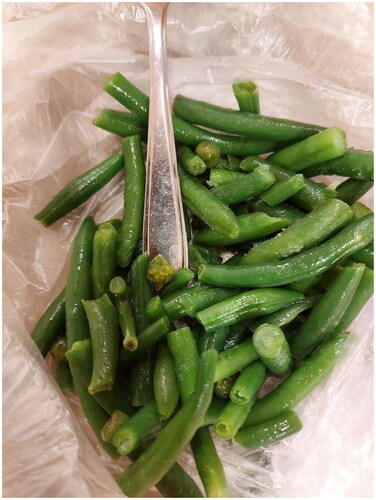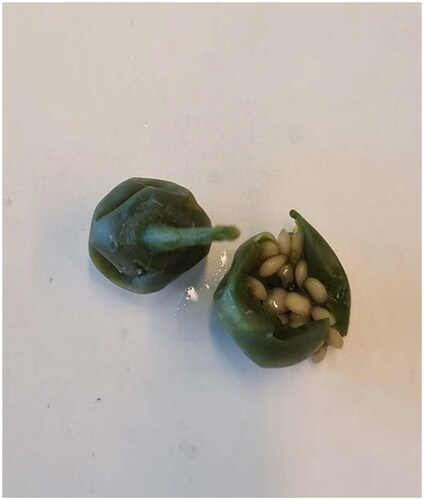Abstract
Introduction
We describe a rare food contamination of organically grown frozen green beans with Solanum nigrum, also called black night shade, which were widely available in supermarkets in the Netherlands.
Case series
To our knowledge, only three adults and one child were referred to the emergency department for observation after eating the contaminated green beans. Only minor symptoms were seen during observation. The remainder of the frozen green beans were obtained from the patients and sent for analysis within one day. Within two and a half days after the first case, a public safety warning and recall were launched.
Discussion
Due to an increase in popularity of organic food, more incidents involving toxic weed contaminants like the one we describe in this report could happen when quality control in organic agriculture is insufficient. In this event, the critical control point obtained from the hazard analysis was insufficiently managed by the producer.
Conclusion
This report demonstrates the efficient collaboration between the Dutch Poisons Information Centre, treating physicians at the hospital and the Netherlands Food and Consumer Product Safety Authority in case of a possible public safety issue. Because of quick acting and collaboration between the involved parties, the product was quickly withdrawn from the market.
Introduction
Solanum nigrum (black nightshade) contains solanine and other glycoalkaloids, with the highest content in the unripe green berries. Symptoms of solanine poisoning are typically gastrointestinal and neurological in nature. In severe poisoning, life-threatening cardiovascular symptoms can occur [Citation1–4]. The concentration of toxins may vary; therefore, it is difficult to establish an association between the amount of plant material ingested and the severity of symptoms. There is no specific antidote for solanine poisoning.
Problematically, Solanum nigrum is a widespread weed in many crops meant for food consumption [Citation5, Citation6]. In conventional agriculture, weed control is performed with synthetic pesticides. Organic farming prohibits the use of synthetic pesticides, which makes weed management more challenging. To ensure food safety, sufficient and effective safety controls need to be in place to prevent toxic weeds ending up in food for human consumption. We describe a product of organic farming in which quality control was insufficient. This led to contamination of plant material of Solanum nigrum in frozen green beans sold in supermarkets throughout the Netherlands.
Case series
The Dutch Poisons Information Centre (DPIC) was contacted late in the evening by a general practitioner regarding two biologists (60 and 63 years old), and their son (32 years old). They had eaten a meal with green beans. Afterwards, they discovered bitter-tasting ‘berry-like’ substances in the pan ( and ). Because of their education as biologists, they recognized them as berries of Solanum nigrum. One patient vomited 2h after eating the meal and after looking in the cooking pan and realizing the berries were Solanum nigrum. Because of the many uncertainties regarding this event (origin of the green beans, proper identification of the structures, number of berries eaten, etc.), the Dutch Poisons Information Centre advised them to go to the hospital and indicated the need for more information. During examination, one patient felt nauseous, and another was tachycardic (127 beats/min) with a normal blood pressure (123/77 mmHg). The emergency department contacted the Dutch Poisons Information Centre, which advised administration of activated charcoal and admission for observation. Activated charcoal was given to all three patients 3 h after ingestion, and they were admitted for observation and telemetry. During observation they did not develop further symptoms. The patient's heart rate quickly normalized. It remains unclear if this was a symptom of (mild) toxicity or was stress related. The patients had no relevant medical history, only the mother was known to have rheumatoid arthritis. After 12 h observation, all three patients were discharged. The Netherlands Food and Consumer Product Safety Authority (NVWA) was informed of the incident that same morning. This case was the initial start of the recall-procedure of the product. A few days after the market withdrawal, the Dutch Poisons Information Centre was contacted regarding a one-year-old girl who had consumed green beans. During the meal, the parents discovered bitter-tasting berries in the meal. By that time, their daughter had eaten half a plate of vegetables. They discovered the public safety warning online and their product matched the batch number. Due to the unknown quantity eaten by the child, the Dutch Poisons Information Centre advised her to be brought to the hospital for activated charcoal and observation. At the hospital, attempts to administer activated charcoal were unsuccessful. The child was monitored for 12 h and did not develop any symptoms.
Figure 1. Remnants of the eaten green beans from Case 1 in which several berries (later identified as berries from Solanum nigrum) can be spotted.

Figure 2. A close-up of one of the berries found in the package from Case 1 identified as berries of Solanum nigrum.

A family of two adults, a toddler and a baby, also found unidentified structures among their green beans. Those structures were removed and thrown away. Several hours later they heard of the recall and became worried. The risk of toxicity was considered low, as none of the berries were eaten. No symptoms were reported.
The fourth case was a toddler who was given green beans. The mother did not know if the green beans were from the same batch involved in the recall but was worried anyway. The risk of toxicity was considered low, as the intake was almost one day earlier, and no symptoms were reported.
Serendipitously, two persons from case 1 were biologists and identified the foreign material in their meal as berries of Solanum nigrum. In addition, both the emergency physician and the consultant internist were hobby gardeners. They came to the same conclusion. However, scientific identification remained necessary. The Dutch Poisons Information Centre prompted the physician to notify the Netherlands Food and Consumer Product Safety Authority in order to initiate official determination and safety measures. The Netherlands Food and Consumer Product Safety Authority obtained the product and remnants of the cooked meal from the family the following day. Official determination concluded that the foreign structures were indeed berries of Solanum nigrum. In one handful of frozen green beans, eight unripe berries were counted.
The organic green beans were frozen beans from a store of a supermarket chain in the Netherlands. The supermarket chain was contacted by the Netherlands Food and Consumer Product Safety Authority in order to take measures. The supermarket recalled all batches from the same grower. Within two and a half days after the first case, a public safety warning and recall of the product was launched. Additionally, at every cash register, a pop-up was shown when the product assigned for recall was scanned by the cashier, or at a self-checkout, in case the product was not properly withdrawn from the shelves. This pop-up said not to buy the product, as it was subject to recall.
The Netherlands Food and Consumer Product Safety Authority also contacted the producer of the green beans to investigate the cause of contamination and to instruct them to enhance their safety measures.
Discussion
The frozen green beans described in this paper were produced by organic farming. Organic farming prohibits the use of synthetic pesticides and weed control is applied through means like mulching, manual and mechanical weeding, crop rotation, and crop cover. Although there is a wide debate in academic circles on the quality of organic production and health safety issues, organic food is becoming increasingly popular amongst consumers [Citation7, Citation8]. If demand increases, it could lead to more incidents involving toxic weed contaminants like the one we describe in this article. Even though Solanum nigrum was part of the hazard analysis and critical control point procedure of the company involved, their current measures were not sufficient to eliminate the hazard. Therefore, we recommend every food business operator processing crops to regularly check if their corrective actions to eliminate toxins are still effective.
Conclusions
We describe the contamination of plant material of the weed Solanum nigrum in frozen green beans. The prompt collaboration of the Dutch Poisons Information Centre, the physicians at the hospitals involved, and the Netherlands Food and Consumer Product Safety Authority resulted in a public safety warning and recall of the product. Without these safety measures, more people could have eaten the contaminated green beans with the risk of solanum toxicity, with children in particular at risk. Good collaboration is of utmost importance to avoid any delay in safety measures to be taken. Finally, food business operators processing crops should include effective measures, and check regularly if these measures are effective, in order to avoid any contamination of crops and thereby foods with toxic weeds like Solanum nigrum.
Acknowledgements
The authors like to thank the technicians from the laboratory of The Netherlands Institute for Vectors, Invasive plants and Plant health for their quick and efficient analysis of the sample.
Disclosure statement
The authors report no conflict of interest. The authors alone are responsible for the content and writing of the paper.
Data availability statement
The participants of this study did not give written consent for their personal data to be shared publicly, so due to the sensitive nature of the research supporting data are not available.
Additional information
Funding
References
- Barceloux DG. Potatoes, tomatoes, and solanine toxicity (Solanum tuberosum L., solanum lycopersicum L.). Dis Mon. 2009;55(6):391–402. doi:10.1016/j.disamonth.2009.03.009.
- Smith SW, Giesbrecht E, Thompson M, et al. Solanaceous steroidal glycoalkaloids and poisoning by Solanum torvum, the normally edible susumber berry. Toxicon. 2008;52(6):667–676. doi:10.1016/j.toxicon.2008.07.016.
- McMillan M, Thompson JC. An outbreak of suspected solanine poisoning in schoolboys: examinations of criteria of solanine poisoning. Q J Med. 1979;48(190):227–243.
- Willimott SG. An investigation of solanine poisoning. Analyst. 1933;58(689):431–439. doi:10.1039/an9335800431.
- Edmonds JM, Chweya JA. Black nightshades: solanum nigrum L. and related species. Promoting the conservation and use of underutilization and neglected crops. Rome: International Plant Genetic Resources Institute; 1997. ISBN: 92-9043-321-3
- Coleman M, Kristiansen P, Sindel B, et al. Blackberry nightshade (solanum nigrum) weed management guide for Australian vegetable production. Armidale (AU): School of Environmental and Rural Science, University of New England, Armidale; 2020.
- Gomiero T. Food quality assessment in organic vs. conventional agricultural produce: findings and issues. Appl Soil Ecol. 2018;123:714–728. doi:10.1016/j.apsoil.2017.10.014.
- Yu X, Guo L, Jiang G, et al. Advances of organic products over conventional productions with respect to nutritional quality and food security. Acta Ecologica Sinica. 2018;38(1):53–60. doi:10.1016/j.chnaes.2018.01.009.
